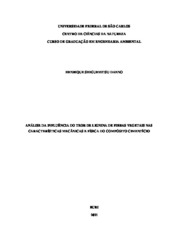| dc.contributor.author | Danno, Henrique Shiguemitsu | |
| dc.date.accessioned | 2021-12-02T14:30:33Z | |
| dc.date.available | 2021-12-02T14:30:33Z | |
| dc.date.issued | 2021-11-08 | |
| dc.identifier.citation | DANNO, Henrique Shiguemitsu. Análise da influência do teor de lignina de fibras vegetais nas características mecânicas e física do composto cimentício. 2021. Trabalho de Conclusão de Curso (Graduação em Engenharia Ambiental) – Universidade Federal de São Carlos, Lagoa do Sino, 2021. Disponível em: https://repositorio.ufscar.br/handle/ufscar/15239. | * |
| dc.identifier.uri | https://repositorio.ufscar.br/handle/ufscar/15239 | |
| dc.description.abstract | Civil construction is an industrial sector that consumes natural resources. To supply this demand, this sector has sought to use alternative sources of material and with positive mechanical performance. This market is looking for new sources of fibers, since asbestos, the most commonly used material, has restrictive restrictions regarding legislation, in addition to steel and polymers that cause negative impacts on its extraction and processing. Limit to Brazil's agricultural potential, vegetable fibers are natural and renewable sources, and can be applied in fiber cement. However, its mechanical performance can vary according to the lignin content. This research project aimed to analyze the influence that the lignin content of vegetable fiber can have on the mechanical strength of fiber concrete, looking for a possibility of establishing a relationship between these two factors in order to predict the feasibility of its use in civil construction. For this research work, there were two types of vegetable fiber with different lignin contents (soybean and bamboo). Vegetable fibers were prepared with drying treatment to remove internal moisture. Subsequently, its critical length was determined by a pull-out test and cut to be incorporated into the fiber cement. The test pieces were molded in body percentages of 0, 2, 6 and 10%, and cured according to NBR 5738 and NBR 5739, respectively. Mechanical strength tests followed NBR 5739. Mechanical strength was provided based on NBR 12655, and the Impact Test followed NBR 13818/1997. It can be demanded that there is a direct relationship between the lignin content and the increase in strength and energy absorption of the concrete. The recommended model with the best results was with an addition of 2% Bamboo fiber. | eng |
| dc.description.sponsorship | Não recebi financiamento | por |
| dc.language.iso | por | por |
| dc.publisher | Universidade Federal de São Carlos | por |
| dc.rights | Attribution-NonCommercial-NoDerivs 3.0 Brazil | * |
| dc.rights.uri | http://creativecommons.org/licenses/by-nc-nd/3.0/br/ | * |
| dc.subject | Material alternativo de construção | por |
| dc.subject | Concreto | por |
| dc.subject | Fibras vegetais | por |
| dc.subject | Teor de lignina | por |
| dc.title | Análise da influência do teor de lignina de fibras vegetais nas características mecânicas e física do composto cimentício | por |
| dc.title.alternative | Analysis of the influence of plant fiber lignin content on the physical and mechanical characteristics of the cementitious composite | eng |
| dc.type | TCC | por |
| dc.contributor.advisor1 | Gazzola, Jonathan | |
| dc.contributor.advisor1Lattes | http://lattes.cnpq.br/0159433721761670 | por |
| dc.description.resumo | A construção civil é um setor industrial altamente consumidor de recursos naturais. Para suprir essa demanda, esse setor tem buscado usar fontes alternativas de matéria-prima e com bom desempenho mecânico. Esse mercado busca, novas fontes de fibras, visto que o amianto, material mais comumente utilizado, apresenta restrições quanto a legislação, além do aço e polímeros que causa impactos negativos na sua extração e beneficiação. Devido ao potencial agrícola do Brasil, fibras vegetais são fontes naturais e renováveis, podendo ser aplicadas em fibrocimento. Porém, seu desempenho mecânico pode ser variável de acordo com o teor de lignina. O presente projeto de pesquisa objetivou analisar a influência que o teor de lignina de fibra vegetal pode provocar na resistência mecânica de concreto acrescido de fibras, procurando a possibilidade de estabelecer uma relação entre esses dois fatores de modo a predizer a viabilidade de seu uso na construção civil. Para esse trabalho de pesquisa, foram analisados dois tipos de fibra vegetal com diferentes teores de lignina (soja e bambu). As fibras vegetais foram preparadas com tratamento de secagem para remoção de umidade interna. Posteriormente tiveram seu comprimento crítico determinado por ensaio de destacamento (pull-out) e cortadas para serem incorporadas ao fibrocimento. Os corpos de prova foram moldados em porcentagens de 0, 2, 6 e 10%, e curados de acordo com a NBR 5738 e NBR 5739, respectivamente. Ensaios de resistência mecânica obedeceram a NBR 5739. A resistência característica foi determinada com base na NBR 12655, e o Ensaio de Impacto seguiu a NBR 13818/1997. Conclui-se que pode haver uma relação direta entre o teor de lignina e o acréscimo de resistência e absorção de energia do concreto. O modelo recomendado com os melhores resultados foi o com acréscimo de 2% de fibra de Bambu. | por |
| dc.publisher.initials | UFSCar | por |
| dc.subject.cnpq | ENGENHARIAS::ENGENHARIA CIVIL::CONSTRUCAO CIVIL | por |
| dc.subject.cnpq | ENGENHARIAS::ENGENHARIA SANITARIA::SANEAMENTO AMBIENTAL | por |
| dc.publisher.address | Câmpus Lagoa do Sino | por |
| dc.contributor.authorlattes | http://lattes.cnpq.br/2032324047982031 | por |
| dc.publisher.course | Engenharia Ambiental - EAm-LS | por |

